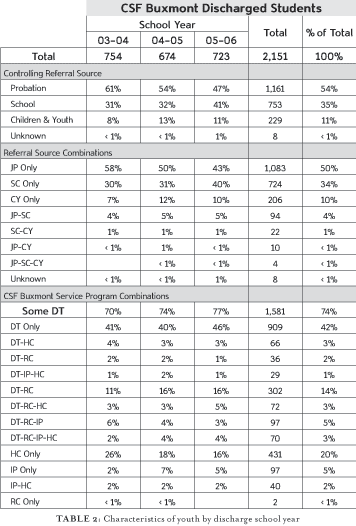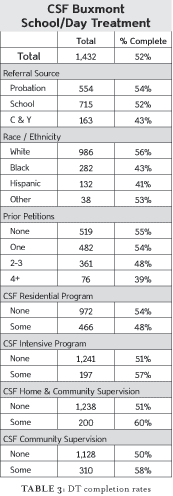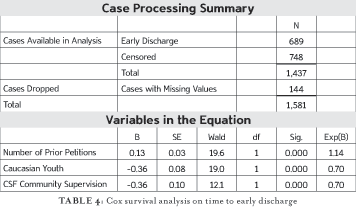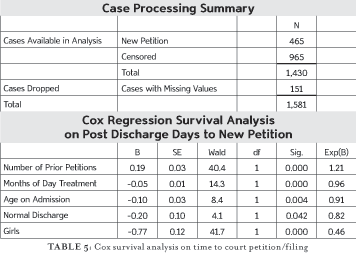Click here to view the original findings for 1999-2001.
Click here to view the the second study, with findings for 2001-2003
This paper reports on the latest (third) phase of an ongoing study, in progress since 1999, which highlights decreases in offending among 3,928 youth discharged from Community Service Foundation and Buxmont Academy's (CSF Buxmont's) restorative programs. The results of all three studies show a dramatic decline in offending rates, achieved through the systematic use of restorative practices, which diminishes only modestly over time.
CSF Buxmont Client Population
A total of 2,151 students were discharged from CSF Buxmont programs during the three school years ending in August 2004, 2005 and 2006. Students were referred from schools (SC), children and youth services (C&Y) and juvenile probation (JP). Characteristics of these CSF Buxmont clients by the referral source are shown in Table 1 *Most (68%) are boys, but a majority of youth referred from C&Y are girls (56%). Overall, most referred youth are white (74%), but a large proportion of C&Y referrals are black (27%) or Hispanic (14%).
 Overall, nearly half (48%) were from Bucks County. The largest proportion of youth referred from C&Y (38%) and probation (70%) are from Bucks County, while a larger share of those referred from school districts are from Montgomery County (36%). These two counties account for 70% of those discharged during these three years, followed by Delaware and Northampton. Other counties (Dauphin, Lebanon, Mercer and Philadelphia) contribute less than 1% of the total.
Overall, nearly half (48%) were from Bucks County. The largest proportion of youth referred from C&Y (38%) and probation (70%) are from Bucks County, while a larger share of those referred from school districts are from Montgomery County (36%). These two counties account for 70% of those discharged during these three years, followed by Delaware and Northampton. Other counties (Dauphin, Lebanon, Mercer and Philadelphia) contribute less than 1% of the total.
CSF Buxmont Program Services
The total number of clients discharged during the three school years remained fairly stable as shown in Table 2, with a high of 754 in the first year and a low of 674 in the second year. Just over half (54%) of CSF Buxmont clients were referred by juvenile probation (JP), a third from school districts (SC), and 11% from children and youth (C&Y). The proportion of probation-referred clients declined while the number referred from schools increased across the three years. Most (94%) clients had only one referral source, but 130 were referred by multiple sources. Nearly three-fourths (74%) of the youth had some exposure to CSF Buxmont school/day treatment (DT) while the rest received only CSF Buxmont Home and Community (HCS) services or CSF Buxmont Intensive Program (IP) services. One-quarter (543) of these youth spent some time in one or more CSF Buxmont Residential Programs (RP), a third (708) received HCS and a sixth (369) received IP services.
One-fourth of the youth participated for 3 months or less in some CSF Buxmont service, half participated for 6 months or less and one quarter for 11 months or longer (mean=8.1 months). Among those participating in DT, half did so for 4 months or less (mean=5.3 months); in RP, half spent 4 months or less (mean=4.5 months). Among those receiving IP services, half participated for 6 months or less (mean=6.0 months), and among those receiving HCS services, half participated for 3 months or less (mean=3.4 months).
CSF Buxmont Program Performance Indicators
Program Completion Rates
There are a number of factors that determine whether those attending CSF Buxmont schools complete the program to normal discharge or are discharged early for a variety of reasons. As shown in Table 3, factors related to school/day treatment completion rates include three interrelated risk factors: referral source, race and prior offending. Students referred by probation or schools had higher completion (54% and 52%) than those referred by children and youth services (43%). Black and Hispanic students completed at lower rates (43% and 41%) than their white counterparts (56%). Those entering with no or one prior court petition completed at a higher rate (55% and 54%) than those with 2 to 3 priors (48%) or 4 or more priors (39%).
 In addition to the characteristics these youth have upon entering CSF Buxmont, their participation in one or more of the CSF Buxmont community programs is related to the proportion completing the school/day treatment to normal discharge, reducing the rate by 6% for residential care, but increasing the rates by 6% for IP and 9% for HCS. Participation in either CSF Buxmont community supervision program (IP or HCS) also increases program completion by 8%. Similar factors accounted for differences in normal completion rates for residential care, IP services and HCS as well.
In addition to the characteristics these youth have upon entering CSF Buxmont, their participation in one or more of the CSF Buxmont community programs is related to the proportion completing the school/day treatment to normal discharge, reducing the rate by 6% for residential care, but increasing the rates by 6% for IP and 9% for HCS. Participation in either CSF Buxmont community supervision program (IP or HCS) also increases program completion by 8%. Similar factors accounted for differences in normal completion rates for residential care, IP services and HCS as well.
In order to determine how these program effects might exacerbate or counterbalance the risk factors, a Cox multivariate survival analysis was used to determine the unique contribution of each of these factors, as shown in Table 4. Prior petitions, being white and participating in either of the CSF Buxmont community supervision programs (IP or HCS) best account for program drop-outs. Once these were accounted for, the negative effect of residential care became non-significant. Thus, it is not the effects of participation in residential care, but rather the risk factors of the youth in that program that explains the lower completion rate.
Program Recidivism Rates
During the spring of 2007, an extensive search of computerized juvenile and adult court records was conducted in Bucks, Montgomery, Delaware, Northampton, Chester, Lehigh and Berks counties, covering 97.5% of the total. All new court petitions other than violations of probation orders were recorded, allowing for a complete delinquency history for each youth for the entire period prior to admission and at least six months subsequent to discharge. Because CSF Buxmont accepts clients with a variety of risk factors and behavioral problems, distinguishing the independent effects of program participation on changing future behavior also requires a multivariate approach. A series of multivariate techniques were used with results reported here reflecting the most sophisticated of these methods (McCold, 2008). As shown in Table 5, the Cox regression survival analysis on days to first court petition in juvenile court or adult court filing revealed five factors significantly related to the time until first court petition. Youth with a higher number of prior petitions were more likely to recidivate; youth who were older upon admission, were female and completed CSF Buxmont school/day treatment to normal discharge were associated with surviving longer without a new petition. Independent of these risk factors, greater participation in CSF Buxmont school/day treatment is associated with less recidivism. These results demonstrate a statistically significant positive program dosage effect on future offending behavior.
In order to quantify the changes in behavior associated with participation in CSF Buxmont programs, it is possible to compare the number of offenses of a client prior to admission to that for the same client during an equivalent period following discharge. The mean number of court petitions per person during the 3 months prior to admission can be compared to the mean number of petitions occurring during the 3 months following discharge, and likewise, periods of 6 months or 12 months prior can be compared to the same periods afterward. Dividing these mean incidence rates by the number of months in the observation period produces a standardized monthly average rate of offending per client and allows changes in different incidence rates to be comparable. Thus, changes in the means for different subgroupings will reveal the magnitude of effects of program participation on reducing offending for those subgroups.
As shown in Figure 1, the longer the time period used in the analysis, the lower the incidence and the less the reduction in the rates, yet all three measured are statistically significant reductions. Computing a percent difference between the pre- and post-numbers creates a consistent way to summarize the magnitude of the change (i.e., [after-before]/before). For the total population, the changes are -62% (n=1,581) for 3 months, -60% (n=1,581) for 6 months and -53% (n=1,254) for 12 months. That is, for all pre-post time windows, the average number of petitions per person per month was reduced by more than half.
 As was demonstrated in Table 5, the recidivism rates were determined by a combination of the effects of prior petitions, age on admission, gender, type of discharge and length of participation in CSF Buxmont school/day treatment. Using the middle-range recidivism measure (6-month pre-post time periods) it is possible to compare the magnitude of the individual factor effects. For example, as shown in Figure 2, the changes in the rates were more dramatic for those completing the program (-65%) than they were for those with an early discharge (-52%), both significant at p<.001.
As was demonstrated in Table 5, the recidivism rates were determined by a combination of the effects of prior petitions, age on admission, gender, type of discharge and length of participation in CSF Buxmont school/day treatment. Using the middle-range recidivism measure (6-month pre-post time periods) it is possible to compare the magnitude of the individual factor effects. For example, as shown in Figure 2, the changes in the rates were more dramatic for those completing the program (-65%) than they were for those with an early discharge (-52%), both significant at p<.001.
 Figure 3 demonstrates that students participating for more than 6 months in CSF Buxmont programs had greater reductions in incidence rates (-72%) than those with less than 6 months (-52%), again both significant at p<.001. Some indication of the diminishing returns from extended CSF Buxmont program participation is indicated in Figure 4. Differences in reductions of recidivism were much more dramatic for those with less than 4 months (-42%) than for those participating for 4 to 8 months (-69%) and 9 or more months (-75%). Thus, overall, the effective length of participation for producing the largest declines in offending rates occurs at about 6 months.
Figure 3 demonstrates that students participating for more than 6 months in CSF Buxmont programs had greater reductions in incidence rates (-72%) than those with less than 6 months (-52%), again both significant at p<.001. Some indication of the diminishing returns from extended CSF Buxmont program participation is indicated in Figure 4. Differences in reductions of recidivism were much more dramatic for those with less than 4 months (-42%) than for those participating for 4 to 8 months (-69%) and 9 or more months (-75%). Thus, overall, the effective length of participation for producing the largest declines in offending rates occurs at about 6 months.
Another way to view these results is to inspect the prevalence rates for those participating in CSF Buxmont for different lengths (i.e., receiving different dosages).
 Figure 5 shows the percent with a court petition during the year after CSF Buxmont discharge for each additional month of program participation (n=1,257). The incidence rate fluctuates widely but displays a general linear decline of about 1.3% reduction per additional month of participation. These data better fit a second-order polynomial trend line as shown in Figure 5. A visual inspection of this chart suggests a tipping point of effective dosage occurring after about 6 months of participation.
Figure 5 shows the percent with a court petition during the year after CSF Buxmont discharge for each additional month of program participation (n=1,257). The incidence rate fluctuates widely but displays a general linear decline of about 1.3% reduction per additional month of participation. These data better fit a second-order polynomial trend line as shown in Figure 5. A visual inspection of this chart suggests a tipping point of effective dosage occurring after about 6 months of participation.
These results continue to confirm a significant recidivism suppression effect from participation in CSF Buxmont programs for at-risk and delinquent young people. The reduction is in direct relationship to the length of program participation and it persists independent of the effects of pre-existing risk factors such as age at first offending, number of prior petitions, gender and race. Thus, the general findings reported from analysis of earlier client cohorts (McCold, 2002, 2004) continue to be supported in this more recent cohort.

References
McCold, P. (2008). Evaluation of a restorative milieu: Restorative practices in context. In H. Ventura (Ed.), Restorative justice: From theory to practice (pp 99-138). Sociology of Crime, Law and Deviance Series Volume 11. Bingley, UK: Emerald Group Publishing Ltd.
 McCold, P. (2004, November). Evaluation of a restorative milieu: Replication and extension for 2001-2003 discharges. Paper presented at the annual meeting of the American Society of Criminology, Nashville, TN.[http://iirp.edu/pdf/erm2.pdf]
McCold, P. (2004, November). Evaluation of a restorative milieu: Replication and extension for 2001-2003 discharges. Paper presented at the annual meeting of the American Society of Criminology, Nashville, TN.[http://iirp.edu/pdf/erm2.pdf]
McCold, P. (2002, November). Evaluation of a restorative milieu: CSF Buxmont School/Day Treatment programs 1999-2001 evaluation outcome technical report. Paper presented at the American Society of Criminology Annual Meeting, Chicago, IL. [https://www.iirp.edu/images/pdf/erm.pdf]

